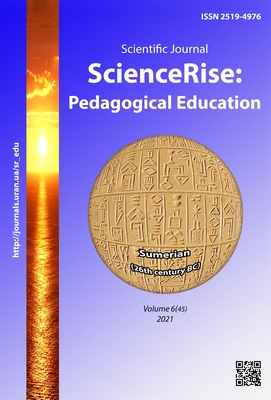The role of educational work in educational institutions in order to prevent the influence of harmful factors on the human body
DOI:
https://doi.org/10.15587/2519-4984.2021.249006Keywords:
toxic substances, cosmetics, ingredients, allergy, allergic reaction, allergens, allergen skin tests, preventionAbstract
The growing number of allergic diseases among people is a global problem. The article considers the role of educational work among students as an important component of knowledge formation about the causes of allergic diseases, prevention methods and maintaining a healthy lifestyle. It is established, that this problem is relevant in the world and requires the introduction of a system of measures to overcome it. The prevalence of allergic diseases has tripled in the last 10 years and to date allergies have reached pandemic proportions. The stages of allergic reactions and possible causes of allergic diseases (genetic, environmental, social) are indicated. The result of immunodeficiency as a result of allergies is the development of various complications or chronic diseases that can lead to disability and even death. The complex epidemiological situation in the world with a large increase in the number of allergic diseases requires constant monitoring to understand current trends. It is taken into account, that there are no statistical data on the level of prevalence of allergic diseases among the population of Ukraine, the study of epidemiological and preventive areas is relevant.
The problem of allergic manifestations was considered among the applicants for education of Zhytomyr Pharmaceutical Basic Vocational College. It has been found, that students of the college already have certain professional competencies: demonstrate knowledge and understanding of the concept of "allergy", the manifestation of allergies, treat the causes and ways of the disease, methods of diagnosing allergens, are informed about historical aspects of disease recognition. It has been proven, that issues, related to allergies, worry students because of the causes of their allergic reactions and diseases. It has been found, that students want to continue to receive and deepen modern knowledge on prevention, causes and types of allergic manifestations and ways to eliminate them. As a result of the analysis the actual questions of students and the necessary answer to them, teachers and specialists-allergists have been revealed.
The importance of information work among applicants for pharmaceutical education, which in their daily work will constantly use toxic substances, drugs and cosmetics that contain substances – allergens, has been traced.
Substantiation of the need to develop effective systems of actions for prevention, diagnosis and provision of treatment and prevention care to the population has been presented
References
- World Allergy Organization (WAO) Diagnosis and Rationale for Action against Cow's Milk Allergy (DRACMA) Guidelines (2010). Pediatric Allergy and Immunology, 21. doi: http://doi.org/10.1111/j.1399-3038.2010.01068.x
- Voronenko, Yu. V., Kuznetsova, L. V., Pukhlyk, B. M. et. al.; Voronenko Yu. V. (Ed.) (2008). Alerholohiia. Kyiv, 366.
- Okhotnikova, E. N. (2008). «Allergicheskii marsh»: sviaz pokolenii i eskalatsiia allergii u detei. Klіnіchna іmunologіia. Alergologіia. Іnfektologіia, 4 (15). Available at: https://kiai.com.ua/ru/archive/2008/4%2815%29/article-199/-allergicheskiy-marsh-svyaz-pokoleniy-i-eskalaciya-allergii-u-detey
- Bala, A. M., Chursinova, Iu. V. (2019). Ispolzovanie multipleksnykh issledovanii dlia personalizatsii profilia sensibilizatsii i prognoza razvitiia allergicheskikh zabolevanii. Allergologiia i immunologiia, 20 (1), 32–33.
- Pukhlik, B. M., Viktorov, A. P., Zaikov, S. V. (2008). Lekarstvennaia allergiia i pobochnye effekty lekarstvennykh sredstv v allergologii. Lvіv: Meditsina svіtu, 107.
- Kordon, T. I. (2008). Food allergies: etiological factors, problems of diagnosis and role in the formation of diseases of the gastrointestinal tract. Naukovyi visnyk Uzhhorodskoho universytetu. Seriia: Biolohiia, 33, 163–167. Available at: http://nbuv.gov.ua/UJRN/Nvuu_2012_33_26
- Radchenko, O. M. (2009). Khronichna retsydyvna kropyvianka z pohliadu terapevta: stan problemy (ohliad literatury). Klinichna imunolohiia. Alerholohiia. Infektolohiia, 8 (27), 38–40.
- Besh, L. V. (2012). Atopichnyi dermatyt u ditei: analiz diahnostychnykh i taktychnykh pomylok. Zdorovia Ukrainy, 3, 34–35.
- Duda, L. V. (2020). Epidemiolohichna kharakterystyka alerhichnykh zakhvoriuvan u ditei za rezultatamy pohlyblenoho obstezhennia. Young science 2.0. Kyiv, 20–22.
- Mokronosova, M. A. (2015). Algoritm allergodiagnostiki s pozitsii dokazatelnoi meditsiny. Astma i allergiia, 2, 3–5.
- Lycc, L. B. (2004). Problemy pischevoi allergii v gastroenterologii. Lechaschii vrach, 4, 68–70.
Downloads
Published
How to Cite
Issue
Section
License
Copyright (c) 2021 Allа Shlianina, Iryna Shelyuk, Svitlana Mulenko, Olena Shemet

This work is licensed under a Creative Commons Attribution 4.0 International License.
Our journal abides by the Creative Commons CC BY copyright rights and permissions for open access journals.
Authors, who are published in this journal, agree to the following conditions:
1. The authors reserve the right to authorship of the work and pass the first publication right of this work to the journal under the terms of a Creative Commons CC BY, which allows others to freely distribute the published research with the obligatory reference to the authors of the original work and the first publication of the work in this journal.
2. The authors have the right to conclude separate supplement agreements that relate to non-exclusive work distribution in the form in which it has been published by the journal (for example, to upload the work to the online storage of the journal or publish it as part of a monograph), provided that the reference to the first publication of the work in this journal is included.








